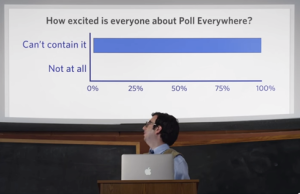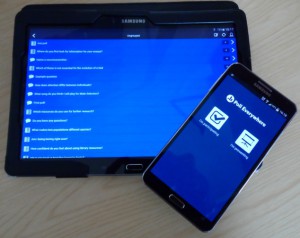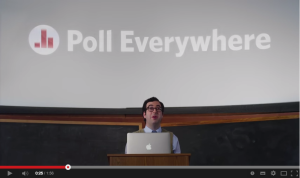
You may have recently heard that, ready for the start of the new term, the University of Sussex has licensed Poll Everywhere.
Poll Everywhere is a student response system that allows students to give instant answers or feedback on presented content, via their mobile phones, laptops or tablet devices.
Poll Everywhere can be used to gather ideas, test knowledge or canvas the opinion of a class/audience.
How does it work?
Poll Everywhere is web-based and can be managed both through a web browser or through the Poll Everywhere app. The user is able to create and launch polls either by using a computer or a smart device, including a mobile phone.
Poll Everywhere allows for three different types of poll to be created; open-ended, multiple choice and clickable image –
- Open-ended – students can give text answers that are as long as they want. The open-ended responses can be set out in a variety of ways, including a text wall and a wordcloud.
- Multiple choice – this gives the students a number of different options to choose from. The results are presented in a graph.
- Clickable image – this option allows you to upload an image which the students can then click on using their computer/smart device. This could be particularly useful for identifying parts of an image. Clickable image can only be used via the web link or the app.
Push your poll
A poll usually starts with a question and you can create as many polls as you like.
Once the poll has been opened (or ‘pushed’), students can reply to questions and polls via;
- the web
- by text
- by Tweet
- via the app
The students replies are instant and can be displayed as part of your PowerPoint presentation on a downloadable slide. The replies are anonymous by default. However, if the tutor wants to set up named respondents, this is possible too.
The responses can be restricted to the number of answers the tutor wishes to allow for each student. After students’ have responded, the results can be collated within Poll Everywhere and exported into an excel file.
You can view this one minute video to see Poll Everywhere being used in a lecture theatre –
What are the benefits of using Poll Everywhere?
- Good integration into PowerPoint
- Variety of ways students can respond (Twitter, text, web)
- Hardware-free (unlike e.g. clickers).
- No sign-up required for respondents (if anonymous).
- Immediately register your participants with a simple CSV
- You can use Maths by typing in latex:
- Easy to use and fun.
What are the limitations?
- Students need either a mobile phone or a smart device with them in order to respond (though the practice of students sharing devices and discussing answers before responding has been shown to have significant learning benefits. For more information see research by Harvard University’s Professor Eric Mazur – summarised in this article http://harvardmagazine.com/2012/03/twilight-of-the-lecture/).
- Unless students create accounts it’s difficult to maintain results for comparison.
- The text message option will charge students on pay-as-you-go contracts the standard network rate.
If you would like to receive training on Poll Everywhere or would like to be added as a user to our licence, please contact tel@sussex.ac.uk or your school Learning Technologist. You can try Poll Everywhere yourself too with just a few clicks of the mouse.
Notes
Image with thanks to creative commons licensed (BY-NC-SA) flickr photo by PitsLamp photography.
Video snapshots with kind permission from Poll Everywhere.







[…] discussions, questions and answers between pairs and the class. Responses are communicated using a student response system. This method provides each student the opportunity to contribute, receive feedback, develop their […]